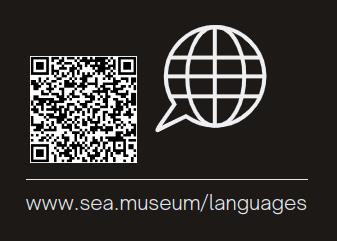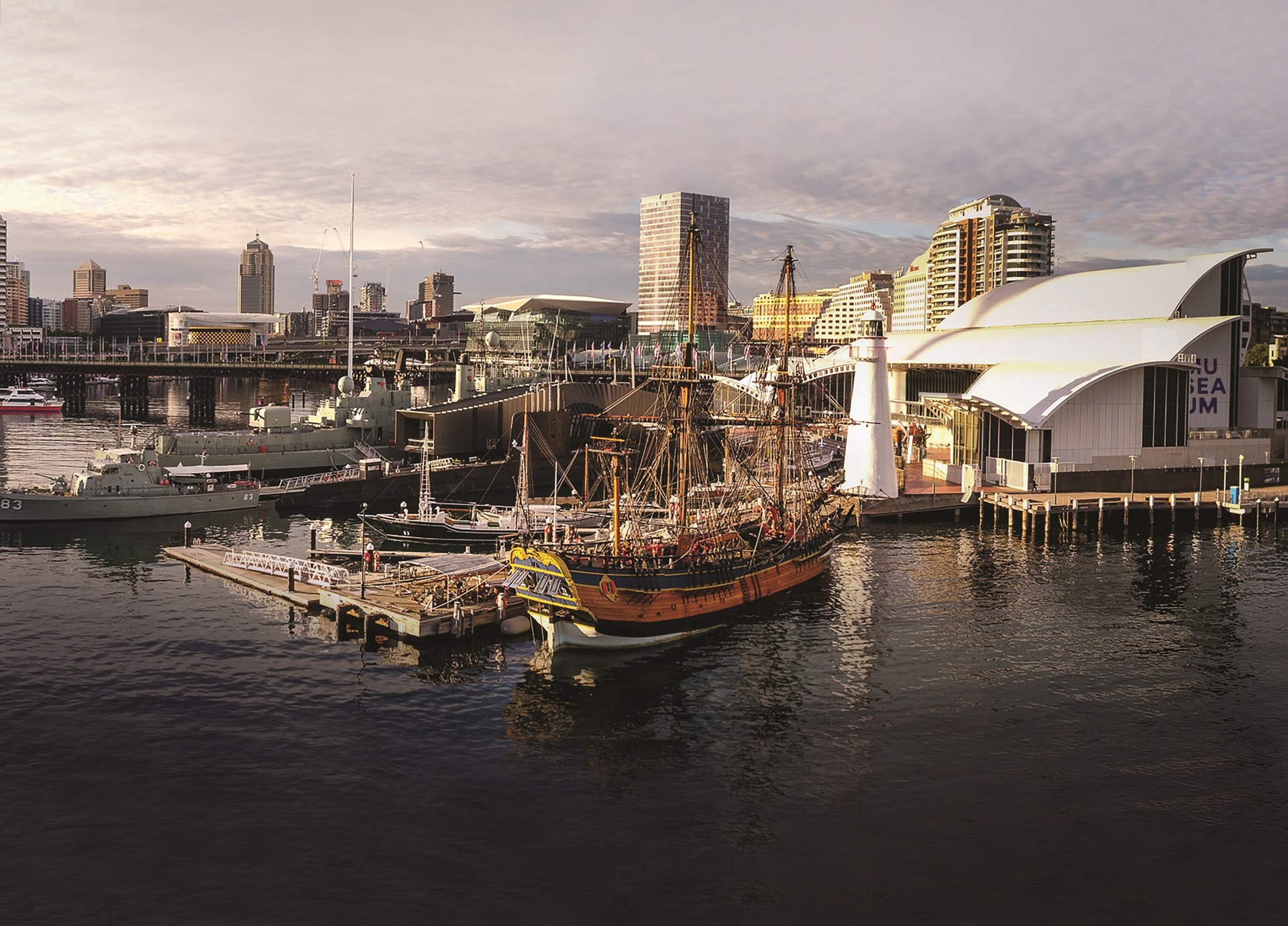Self-Guided Highlight Tour
We are Australia’s museum of the sea. A place to explore our relationship to the oceans, rivers and lakes around us, and to dive deeper into the rich maritime heritage that binds us all.
Australia is an island nation. Australians have always been fascinated by the waters that surround us. The ocean, and its ever-shifting tides, have been central to our stories throughout time, shaping who we are. By sharing these stories, the museum wants to spark curiosity and conversations about how the sea shaped our world and continues to transform us today. Our purpose is to excite people about their connection to the sea, so that we all value it more.
You are welcome to take photographs in all of our vessels and exhibitions.
Please note that our submarine, HMAS Onslow, is only suitable for people who can move freely and are comfortable being in confined spaces. If you have any mobility concerns, we suggest visiting our destroyer, HMAS Vampire.
Highlights Tour:
Stop 1: Acknowledgement of Country (30 min tour, 60 min tour, 90 min tour)
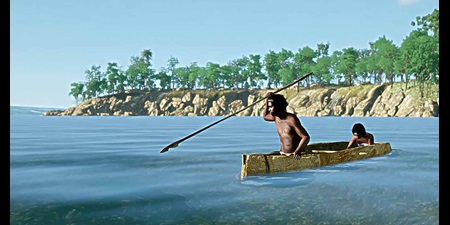
• Australia is home to many Aboriginal peoples who have lived on this continent for tens of thousands of years.
• The Australian National Maritime Museum acknowledges the Gadigal people of the Eora nation as the Traditional Custodians of the bamal (earth) and badu (waters) on which we work.
• We also acknowledge all Traditional Custodians of the land and waters throughout Australia and pay our respects to them and their cultures, and to Elders past and present.
Stop 2: Shaped by the Sea – Entrance Near Foyer (30 min tour, 60 min tour, 90 min tour)
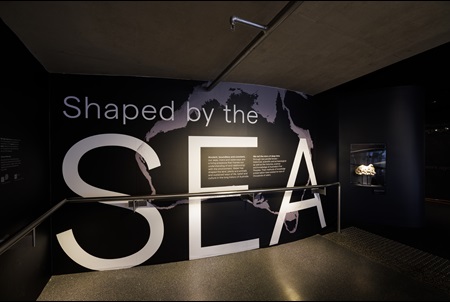
• Shaped by the Sea is a major exhibition from the Australian National Maritime Museum. It tells the story of our island continent, its coasts and rivers, and its peoples.
• Shaped by the Sea includes ancient stories that describe the rising of the seas around Australia’s coastlines. These Aboriginal perspectives are shared with scientific explanations of coastal inundation and sea level rise after the last Ice Age. Two different systems of knowledge are threaded through one story of deep time Australia.
• The exhibition’s design approach takes inspiration from the idea of the sea as a living being. The gallery reflects the movement of water – enjoy its flows and eddies on a journey that connects the land, sea and sky.
• Shaped by the Sea acknowledges and embraces many ways of knowing our past. It highlights the importance of incorporating the presence of living cultural knowledges where seas and rivers can be imbued with social and spiritual connections. These understandings enrich those purely derived from science, archaeology or history.
• The exhibition is informed by traditional knowledges and practices of Australia’s First Peoples, who have lived with and sustained our oceans and waterways for countless generations. Equally it acknowledges that other traditions also foster deep attachments to rivers and waters.
• Shaped by the Sea helps awaken and acknowledge these points of connection, for Australians and for all peoples.
Stop 3: Shaped by the Sea – SEA and Dhaŋaŋ Dhukarr (30 min tour, 60 min tour, 90 min tour)
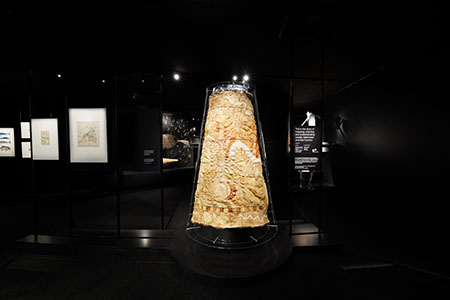
SEA
This is the story of mapping, charting and understanding coasts, waterways and sea country.
• We listen to different perspectives on how many people have mapped and charted our coasts and rivers. European cartography from the 1700s can be compared with a river map on a possum skin cloak created by cultural leaders from the Yorta Yorta people.
• We can see how seas and rivers have been harvested for millennia, including the making of shell fish hooks that are on display.
Dhaŋaŋ Dhukarr ‘Many Pathways’
• A central aspect of the exhibition is Dhaŋaŋ Dhukarr or ‘Many Pathways’ by the Mulka project of North eastern Arnhem Land. This is the traditional home of the Yolŋu people.
• Land, sea and sky converge in the central space called Dhaŋaŋ Dhukarr (Many Pathways) in Yolŋu Dhuwaya language. This is an experience that demonstrates how many of the knowledges represented in the exhibition are not written down in books or depicted in a linear historical manner.
• Aboriginal peoples’ knowledges of Australia’s ecological past are preserved in song, performance and symbolic motifs. They are shared here to help us appreciate Indigenous knowledges, in a way that community members choose to represent their story to audiences today.
• The land, sea, and sky of the Yolŋu world are expressed through the song lines of the various Yirritja and Dhuwa clans. The elemental forms they represent are depicted by The Mulka Project, working with senior traditional artists and Yolŋu digital artists.
• This stunning installation by the Mulka Project is a cyclic reflection on deep time in Australia. As the Mulka Project describe it, Dhaŋaŋ Dhukarr is symbolic of the collective clans represented within the work and the journeys of their songlines performed throughout its cycle.
Stop 4: Shaped by the Sea – Land
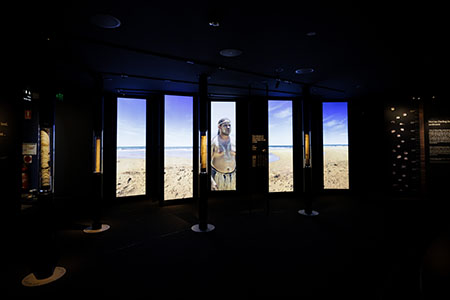
LAND
• Many Australians now understand what Aboriginal people mean when they talk about ‘Country’. Country is not just about land or the earth. It is the sense of place as a living being that shapes and is shaped by the people who dwell on it.
• Our modern understanding of the appearance of the Australian continent is quite different to how the ancestors of the many Aboriginal and Torres Strait Island peoples have seen continental Australia in the past.
• Where once was wetlands are today arid deserts. Mountain tops have become islands. Vast stretches of our coastlines, which sustained generations of families, are today submerged deep beneath the ocean.
• In the exhibition, our journey through ‘Land’ carries us to the reefs where scientists have taken slices of coral to understand thousands of years of sea level changes.
• In the same place we learn from Yidinji dancers of northern Queensland, who perform a story about how their ancestors walked where the Great Barrier Reef now lives, until the sea level rose after the last Ice Age.
Stop 5: Shaped by the Sea - Sky
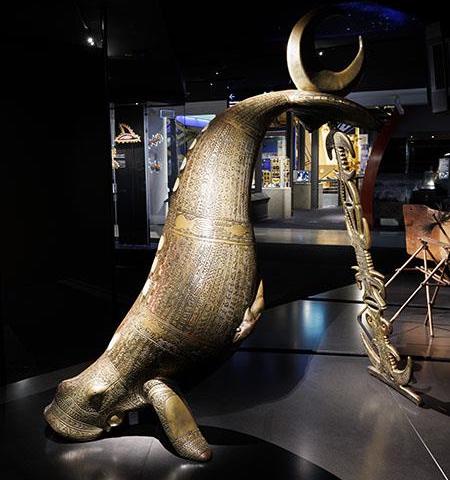
SKY
• These are stories of navigation.
• The view from the sky – whether in Aboriginal paintings or in satellite imagery – reminds us that our coastline is not a wall. It is a way of marking that the land continues under the sea, always interacting with each other. These are the deep truths of deep time that we can all share, regardless of our cultural backgrounds.
• This gallery asks us to think about how we find our way in time and space, based on what we see in the skies.
• Ilma refers both to ceremonies performed by Bardi people and to hand-held objects used to teach stories, songs and law. They can be thought of as navigational instruments and way finding points and depict knowledge of journeys, ancestral and modern in much the same way satellites follow pathways across continents.
• Dugong hunters from Zenadth Kes (Torres Strait Islands) use the moon and stars to find and hunt their prey while modern satellites help us safely navigate the ocean.
• Marvel at a bronze sculpture by artist Alick Tipoti known as Kisay Dhangal (dhangal means dugong in Kala Lagaw Ya language) from Zenadth Kes (Torres Strait Islands). Inscribed with traditional motifs and pearl shell, Kisay Dhangal reflects the life cycle and feeding patterns of the dhangal.
Stop 6: Shaped by the Sea – Entrance Panel closest to Learning Centre
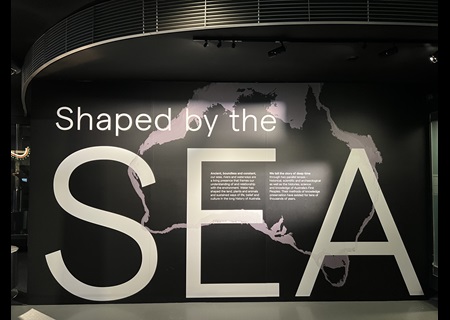
• Shaped by the Sea is a new major exhibition from the Australian National Maritime Museum. It tells the story of our island continent, its coasts and rivers, and its peoples.
• Shaped by the Sea includes ancient stories that describe the rising of the seas around Australia’s coastlines. These Aboriginal perspectives are shared with scientific explanations of coastal inundation and sea level rise after the last Ice Age. Two different systems of knowledge are threaded through one story of deep time Australia.
• The exhibition’s design approach takes inspiration from the idea of the sea as a living being. The gallery reflects the movement of water – enjoy its flows and eddies on a journey that connects the land, sea and sky.
• Shaped by the Sea acknowledges and embraces many ways of knowing our past. It highlights the importance of incorporating the presence of living cultural knowledges where seas and rivers can be imbued with social and spiritual connections. These understandings enrich those purely derived from science, archaeology or history.
• The exhibition is informed by traditional knowledges and practices of Australia’s First Peoples, who have lived with and sustained our oceans and waterways for countless generations. Equally it acknowledges that other traditions also foster deep attachments to rivers and waters.
• Shaped by the Sea helps awaken and acknowledge these points of connection, for Australians and for all peoples.
Stop 7: Vessels (30 min tour, 60 min tour, 90 min tour)
You are welcome to climb aboard all of the historical vessels that are open, on the day of your visit.
Stop 8: Action Stations (30 min tour, 60 min tour, 90 min tour)
• Action Stations is an exciting way for you to experience the compelling history of the Royal Australian Navy (RAN).
• You will need to walk through Action Stations to board both the submarine and the destroyer. If you are on the 60 min tour or 90 min tour, we recommend you may wish to watch the immersive cinema experience which is also called ‘Action Stations’.
• Explore the danger and drama of military life at sea through an immersive journey that shows the inner workings of the Navy like never before.
• This exhibition enlivens our much-loved ex-Royal Australian Navy vessels: HMAS Vampire (Daring class destroyer) and HMAS Onslow (Oberon class submarine). ‘HMAS’ means ‘Her Majesty’s Australian Ship’.
Stop 9: Destroyer - HMAS Vampire (30 min tour, 60 min tour, 90 min tour)
HMAS Vampire, Australia’s largest museum vessel, is the last of the country’s big gun ships. It has six 4.5 inch cannons in three different turrets. Vampire is a destroyer, a fast type of warship for ocean patrols and escort duties.
Daring class vessels such as Vampire were the largest destroyers built in Australia.Their strong, light construction combined high speed with maximum armament. Later destroyers used missiles as their main weapons.
Despite its firepower, Vampire had a peaceful career, even while escorting troops to the Vietnam War in the 1960s. In 1977, Vampire had a brush with royalty as the RAN escort for HMY Britannia during the Queen’s Silver Jubilee tour of Australia.
Stop 10: Submarine - HMAS Onslow (30 min tour, 60 min tour, 90 min tour)
Venture into the secret world of submarine warfare on HMAS Onslow.
Our submarine was launched in 1969 and decommissioned in 1999, just weeks before coming to the museum. It’s still close to operational condition. So, if you go onboard, listen out for the diving alarm!
With 5 other Oberon-class submarines, Onslow gave the Royal Australian Navy a formidable underwater force. The motto of the navy’s submarine arm is “Strength, silence, surprise”.
This explains many of Onslow's characteristics, including:
• a diving chamber for Special Forces to leave the boat for covert operations
• a gash ejector containing weighted rubbish (gash) bags. When ejected, the bags sink to the ocean floor so no debris floats to give away the submarine’s position
• soundproofing on all equipment to make Oberons one of the quietest class of submarines ever built.
Onslow has travelled the equivalent of more than 16 times around the world, serving Australia with quiet distinction for 30 years.
Stop 11: Sailing ship – Duyfken (90 min tour)
This small ship is a replica of one that sailed from Europe to Asia over 400 years ago!
This colourful sailing ship is named Duyfken, a Dutch word which means ‘little dove’. It is a replica of a vessel that sailed from the Netherlands to Indonesia in 1601. It also visited northern Australia in 1606.
Ships like this one created maritime links between Asia and Europe. Between 1600 and 1900, the Dutch established trading networks in India, Indonesia, China, Japan and Korea. Imagine travelling so far in a small, rocking boat like Duyfken!
Go aboard Duyfken to see:
- the tiny captain’s cabin at the stern (back) of the boat – this was the only place for privacy
- the pole or ‘whipstaff’ used to help steer the boat, instead of the wheel that was later adopted
- the cannons which are like those used in battle against Portuguese ships in Indonesian waters four centuries ago
The museum’s replica Duyfken was built in Fremantle, Western Australia. Since 2000 it has sailed to Indonesia, Papua New Guinea, Holland and right around Australia.
Stop 12: Tall Ship - HMB Endeavour (30 min tour, 60 min tour, 90 min tour)
The Australian-built replica of James Cook’s HMB Endeavour is one of the world’s most accurate maritime replica vessels.
• When you come on board you may wonder whether James Cook and his crew have just stepped ashore somewhere on their voyage. The table is set, clothes are hung and the cat is slumbering.
• This beautifully crafted ship offers a glimpse a sailor's life during one of history's great maritime adventures, Captain Cook's epic 1768-71 world voyage. The masts carry 28 sails that spread approximately 10,000 sq feet (930 m2) of canvas. Our Endeavour still regularly goes to sea!
• In the galley below is the huge stove, called a firehearth - state of the art in 1768. The Great Cabin at the rear is where Cook worked and dined, sharing the space with famous botanist Joseph Banks.
• Construction of the Endeavour replica began in 1988 and the ship was launched 5 years later. Since then, Endeavour has covered many nautical miles on long voyages. It has circumnavigated Australia three times, as well as sailing to Europe, the USA and other overseas ports.
• In 2022, the museum’s maritime archaeologists identified the shipwreck of the original Endeavour – at the bottom of Newport Harbor in Rhode Island, USA.
